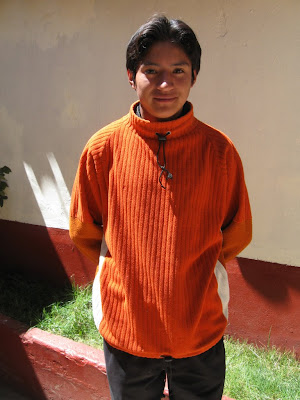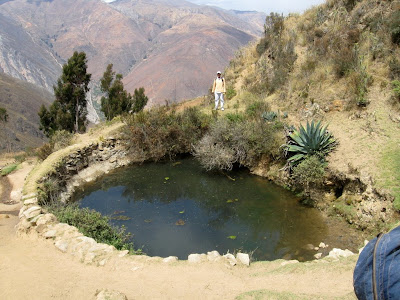
As we passed through Huancayo, we saw hundreds of people in all styles of dress, from modern to traditional. This woman, in traditional attire, was walking along one of the main streets of Huancayo:

As we drove into the high mountains south of Huancayo, we could see that the farmlands had dried out:

This is the same view from last April, at the end of the rainy season:

Another example of a dried-out hill with farmlands:

... and the same view from last April:

When we arrived in Izcuchaca, we stopped to take close-up pictures of the picturesque Spanish colonial bridge:

On the city side of the tower, we could see the steps that Spanish solders climbed to watch for enemies from the bridge:

On our way back from Huancavelica, in the mountain town of Ccaccasiri (a Quechua word prounced Hah-hah-see-ree; the double-C has a hard H sound), we passed through the middle of the Sunday market:

People gathered at the market to buy many different kinds of things: yarn, clothing, detergent, soda, dishes, soup kettles, etc.:

We spent the night in Huancayo. At dusk, we had a bird's eye view of the cathedral dome from the hotel roof near our room:

We noticed the contrast between the ancient cathedral and the modern high-rise office building in the background:

At various locations on our route, we saw adobes (bricks) stacked and waiting to be used for making houses and other small buildings:

Because it's the end of harvest time, we saw many farmhouses where the straw had been stacked to feed the animals until next year's crop.

... and fields where the straw was still waiting to be harvested:

We are now at the beginning of the "burn season," when sheep and cattle herders burn the dried hills so that more nutritious pasture grasses will grow next season:

Even though we've been to Huancavelica five times now, we always see new things as the seasons change. We never tire of the trip.







































